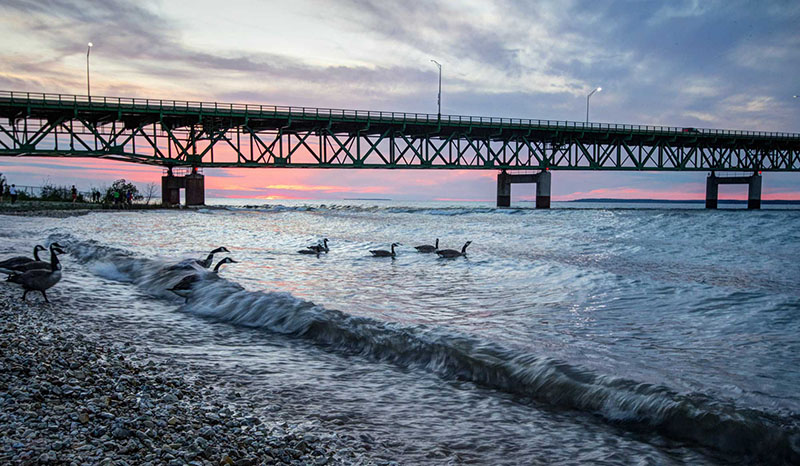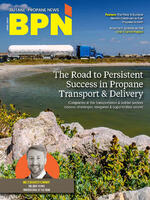
In the November 2024 issue of BPN, Derek Dalling — president and CEO of Dalling & Associates Inc., a major lobbying firm in the propane industry — gave an update on the status of the Line 5 pipeline project underway in Michigan. In his overview of the then-current legal challenges, Dalling made a case for the tunnel project, citing the increase of energy offerings in the area and the environmental security of further protecting the pipeline.
Dubbed the “Great Lakes tunnel” for its location under the Straits of Mackinac, the proposed construction of a protective tunnel around the Line 5 oil pipeline would be funded entirely by Enbridge, a large company that oversees the Line 5 pipeline and manages over 110,606 miles of gas transmission across parts of Canada and the United States, according to the company’s website.
While advocates of the Great Lakes tunnel tout the overall good of the pipeline and its positive economic impact on the area, the tunnel project, as well as the pipeline itself, has not been without its critics.
Before digging further into the more recent updates and status of the ongoing discussion around the tunnel project, it could be helpful to zoom out and review the history of the pipeline.
A Brief History of Line 5
By 1953, the year the Line 5 pipeline was completed by Bechtel Corporation, oil transportation had come a long way since the first pipeline was constructed. Made of iron and 2 inches in diameter, the world’s first pipeline — built by hand in Pithole, Pennsylvania — was an endeavor spearheaded by the innovative oil buyer Samuel Van Syckel in 1865. In what was perhaps an omen of things to come, the project was met with such staunch — and at times violent — resistance from the workers whose jobs it was replacing, Van Syckel deployed his own private militia to guard the pipeline from would-be attackers. In spite of the looming threat of discontented workers, soon thereafter pipelines were crisscrossing all over Pennsylvania and beyond.
In the 1950s, pipeline technology had advanced well beyond the innovations of Van Syckel. Bolstered by the boom in innovation from World War II, the minds at Lakehead Pipeline Company (which would later come to be known as Enbridge) developed plans to construct a seamless steel pipeline that would transport oil from Superior, Wisconsin, to Sarnia, Canada. Upon completion, the pipeline would offer a safer and more efficient method of oil transportation, especially through the tricky Straits of Mackinac. Previously, oil tankers had to take the slow and sometimes risky treks through the waterways between Superior and Ontario, a path that had seen the wrecks of many ships over the years, including the infamous Edmund Fitzgerald.
In 1953, Lakehead Pipeline Company lobbied to pass a bill (Act 10 of 1953) that subsequently cleared the way for the Department of Environment, Great Lakes and Energy (EGLE) — called the “Conservation Commission” at the time — to grant easements for construction on state-owned lands and waterways. Because the push for stricter environmental management at the federal level would not come until much later, the bill passed with minimal environmental restrictions or review. So long as certain engineering safety specifications were met by Lakehead Pipeline Company, the easement allowed the company “to construct, lay and maintain pipelines over, through, under and upon certain lake bottom lands … for the purpose of transporting petroleum and other products.”
Given the current disagreements around the pipeline, it might come as a surprise to learn the project was by and large welcomed and even celebrated by the Michigan community at the time. For many, it was yet another symbol of the innovation and growth in infrastructure taking place in America.
Safety Concerns Grow
For many years, Enbridge enjoyed relative peace and quiet in the public eye as the silent pipelines did their important work at the bottom of the Great Lakes. All of that changed in 2010, when Enbridge’s Line 6B spilled over 800,000 gallons of oil into the Kalamazoo River, located in Michigan. The spill garnered greater concern from the public and the Michigan government regarding the real risks posed by the Line 5 pipeline. A spill in the Great Lakes could be catastrophic.
To make matters worse, the spill was attributed to Enbridge’s failure to maintain the safety of the 6B pipeline. With further scrutiny being given to the safety of the pipelines, it was discovered that Enbridge had violated Section (A) (1) of the original 1953 Line 5 easement agreement, which states that “the maximum span or length of pipe unsupported shall not exceed 75 feet.” As far back as 2001, Enbridge has applied for emergency permits to add anchoring supports to the pipeline, requests that the EGLE (then called the Department of Environmental Quality) has largely granted. However, in 2014, Enbridge submitted documentation to the state of Michigan that revealed that since at least 1963, there have not been support anchors at the required 75 feet mark as laid out in the agreement. Enbridge had been violating the easement agreement for at least 50 years. What is more, during the process of installing additional safety anchors in 2014, the pipeline’s protective coating was damaged — a fact that Enbridge did not disclose until three years later. In 2016, amid growing concerns from the public and the Grand Traverse Band of Ottawa and Chippewa Indians in particular, EGLE allowed permitting for four of Enbridge’s proposed anchor additions but denied permitting for an additional 18 anchors.
Tensions continued to ramp up between government regulatory bodies and the status of the pipeline. In 2017, the state of Michigan struck an agreement with Enbridge, called the First Agreement, that the company would amend gaps in the line’s protective coatings and meet certain operational safety measures. The agreement also called for Enbridge to study alternative options to the pipelines. Less than six months later, a boat anchor rammed into Line 5, causing the pipeline to receive two dents on the western line and one on the eastern line. The pipeline’s already questionable safety status was quickly becoming more urgent.
In October 2018, Michigan entered into another agreement with Enbridge, dubbed the Second Agreement. This agreement called for the construction of a tunnel that would protect a new portion of the pipeline under the Straits of Mackinac, funded entirely by Enbridge. The Great Lakes tunnel project was born.
Conflicting Government Mandates & Present-Day Legal Challenges
In a twist of irony, the same government that entered into an agreement with Enbridge to construct the Great Lakes tunnel would soon oppose both the tunnel project and the pipeline itself. The new Michigan governor, Gretchen Whitmer, who took office in January 2019 alongside Attorney General Dana Nessel, publicly opposed the Line 5 pipeline. Shortly after taking office, Nessel filed a lawsuit against Enbridge, claiming the original easement should be void and the pipeline should cease operations. In 2020, Governor Whitmer cited violations of the public trust doctrine and sent a notice to Enbridge that the 1953 easement was revoked.
In a relatively short time span, Enbridge has become embroiled in more legal difficulties and challenges than it has ever experienced in its 75-plus years of existence. The number of lawsuits involving Enbridge is significant and difficult to track.
One lawsuit, initiated by Enbridge, pushed back against Nessel’s formal legal opinion issued in 2019 that the state legislature was not operating in line with the Michigan Constitution when it created the Mackinac Straits Corridor Authority and entered into the Tunnel Agreement with Enbridge. Since BPN’s November 2024 article covering Line 5, the Michigan Court of Appeals has found that the Michigan legislature acted within its rights and that the agreements between Michigan and Enbridge were valid. The decision was welcomed by many in the propane industry, including the National Propane Gas Association.
Another lawsuit, initiated by the Bad River Band of Lake Superior Chippewa, resulted in a federal judge giving Enbridge until 2026 to shut down parts of the pipeline that run through reservation land. As part of a long-term solution to the decision, Enbridge proposed a 41-mile reroute of the pipeline around reservation land, a plan that was permitted and approved by the Michigan Department of Natural Resources, but which has since been met with more opposition from the Bad River Band tribe. Both Enbridge and the Bad River Band tribe have appealed the court decision before the U.S. 7th Circuit Court of Appeals.
Enbridge has also filed a case against Governor Whitmer and the Department of Natural Resources in federal court over the governor’s aforementioned 2020 notice calling for the pipeline to cease operations. In the lawsuit, Enbridge claimed the state of Michigan was unlawfully interfering in the pipeline’s operation. In a recent update in late April, the U.S. Court of Appeals for the 6th Circuit reviewed the case and found that Enbridge’s lawsuit could proceed in federal court. The appeals court disagreed with the defendant’s arguments that Enbridge’s lawsuit violated 11th Amendment sovereign immunity. This marked another victory for Enbridge.
Perhaps the most significant lawsuit on watch right now is one brought by Nessel in 2019, seeking to void the original easement agreement with Enbridge. The case has been remanded to Michigan state court, a decision affirmed by the 6th Circuit Court of Appeals and a step that is seen by many as an early success for the attorney general. However, no one is sure of how the various cases involving Enbridge will turn out. In a legal web as complicated as this — which involves various cases, safety reports, governmental agencies, appeals courts and a new administration’s executive orders declaring an energy emergency — it will require time to fully understand the fate of the Enbridge Line 5 pipeline and the communities it impacts.
Reflections on Line 5 & the Energy Conversation
At the heart of the debates surrounding Line 5 and the Great Lakes tunnel project is a valid question about American energy. How can we balance the type of innovation put on display in the Line 5 pipeline, which led to affordable and accessible energy options for everyday Americans, while taking care of the planet we all call home?
Unfortunately, there are no easy answers to this question. We can no longer deny the impact that our human habits have on the climate. But it is equally true that any environmentally friendly solution must be human friendly, ensuring the affordability and reliability that fuels a flourishing community.
One helpful example of a possible way forward is the “wide path approach” to clean energy advocated by Tucker Perkins, president and CEO of the Propane Education & Research Council. It seems unlikely that one energy solution will have the final say in our future energy landscape. Whatever the specific answers are, it’s clear propane will have a role to play.


